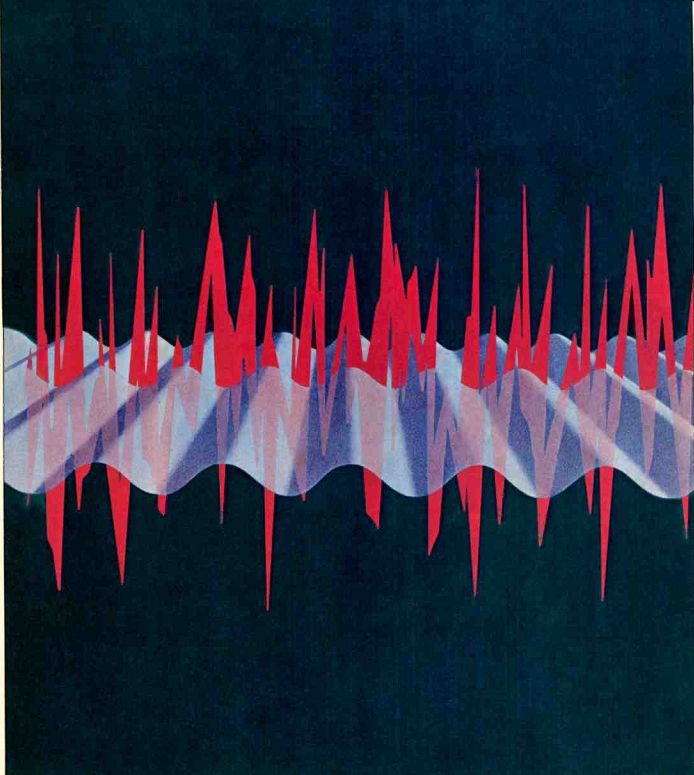
By Ralph Hodges
---The DNR device is essentially a dynamically controlled LPF that is inexpensive, simple and compact in implementation, and reasonably free of audible side effects.---
National Semiconductor, one of the nation's oldest and certainly one of the leading makers of integrated circuits, is by no means new to noise reduction. Selling Dolby B-type integrated circuits to cassette-deck manufacturers is one of the higher volume activities of its consumer linear division, and you can be sure that other products of its manufacture turn up as gain blocks in many alternative noise-reduction systems. What the company has not conspicuously participated in is the design of noise-reduction processors. Indeed, making component parts for everybody else's NR system-and everybody else's electronic anything, for that matter--would seem to be business enough, why should it get further involved? Or, rather, why has it, because National Semiconductor's DNR (Dynamic Noise Reduction) amounts to just that sort of involvement? The reason, according to the company, is that noise reduction in its commonly encountered compander form is all well, all good, but all too rare. Efforts by Dolby Labs notwithstanding, FM broadcasts are still largely compander-un-encoded. The cassette you play in your portable "tape player cum headphones" may be encoded, but it's unlikely that the player will be able to decode it, and the hiss from a diaphragm within an inch of your ear is hard to ignore. You can buy encoded discs from dbx, but perhaps not with the performers and performances you'd most prefer. Although tomorrow's videodiscs may be encoded with some form of noise-reduction processing, today's are not. The same goes for the majority of prerecorded videocassettes. The future (AM stereo, stereo TV) remains clouded, but the past is clear, and much of it is made up of recorded material that never had a chance to benefit from practical noise reduction.
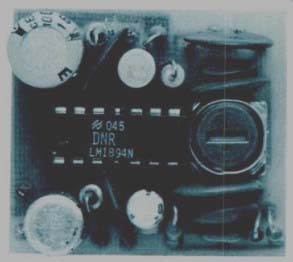
---The DNR scheme seems an appropriate solution to an inherently insoluble
problem.---
Of course, the situation is not new, but, ironically, new media and program sources are making it more prevalent. In response, National Semiconductor has seized on a solution that is also not strictly new, but which is probably timely.
Now, the company believes, is the right moment for noise reduction that can cope with sources which already contain noise. This means a "single-ended" processor--one that steers its way between program and noise, lopping off the latter insofar as it is able to separate such noise out. The DNR device is essentially that of a dynamically controlled low-pass filter, but one that skirts negatives in previous designs of this sort, which as a rule were not (1) inexpensive; (2) simple and compact in implementation, and therefore adaptable to a broad spectrum of products, and (3) free as they could be of audible side effects.
DNR is all of these according to National Semiconductor, who expect its appeal to grow rapidly as the word gets around.
Basics of Operation In its latest form, DNR consists of a single IC (National Semiconductor LM 1894) for two channels, plus a number of external components (see sidebar). As shown in Fig. 1, a single control circuit regulates the filter action of both audio channels, which can vary in bandwidth from 800 Hz to as much as 30 kHz (-3 dB points). Maximum nose reduction (CCIR/ARM weighted) is in the neighborhood of 10 to 14 dB. The filters are single-pole configurations, providing a uniform 6-dB per octave roll-off above whatever corner frequency the voltage from the control circuit dictates (see Fig. 2 for operating parameters). The control circuit itself derives a control signal from the rectified sum of :he two channels. The circuit's response is not uniform with frequency, but increases at a 12-dB per octave rate from about 1 to 6 kHz, flattening out above. A threshold, sometimes fixed but user-variable in the case of one available outboard processor, establishes the noise "floor" of the system, determining what levels of high-frequency energy will be construed as noise (for which the filters will remain closed) and what levels as program (for which the filters will progressively open up). The filters can open (attack time) in as little as 0.5 millisecond, which is consistent with the sharpest transients to be expected in program material. Release time is a more leisurely 50 milliseconds, to avoid the foreshortening of any lingering reverberation.
Considered within the constraints of cost, simplicity and playback-only processing, the DNR scheme seems an appropriate solution of an inherently insoluble problem. The time constants (attack and release) are well chosen in terms of present-day psychoacoustic understanding, and the operational frequency bands are the right ones for maximum suppression of audible steady-state noise (hiss, in other words). Governing the action of the control circuit by higher frequencies alone is a particularly logical idea. It both focuses appropriate attention on the critical area, and avoids control-signal ripples that low-frequency information can impose on a peak-detecting circuit such as DNR employs.
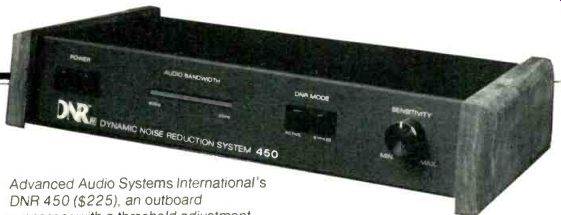
------- Advanced Audio Systems International's DNR 450 ($225), an outboard
processor with a threshold adjustment and an LED display for instantaneous
bandwidth indication, bears the proprietary logo for the National Semiconductor
system. Manufacturer: Advanced Audio Systems, San Jose, Cal.
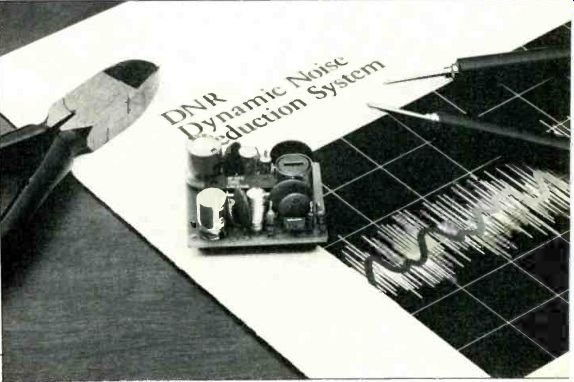
------ National's LM 1894 IC with its external components on a p.c. board.
In common with any practical noise-reduction system, DNR depends on auditory masking of noise by program material occurring at or near the same frequency. If this masking does not take place when the filters open to pass high-frequency program, noise will be heard.
Worse, noise will be heard going up and down in level with the filter action. Such noise modulation--and arranging for masking to conceal it--is the crux of noise-reduction system design. In less guarded moments, all responsible engineers admit that masking is bound to fail under some circumstances, and can be made to fail predictably if program material is chosen with that end in mind. A proper noise-reduction system considers typical listening fare first and foremost, and trusts the flaws won't loom too large when unusual spectral distributions of program overthrow the designers' expectations.
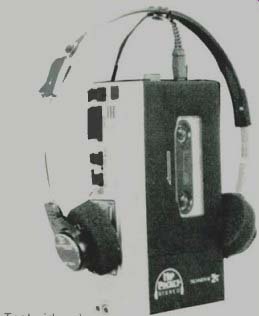
-----------Technidyne's Hip Pocket Stereo incorporates DNR circuitry.
The claims made for DNR in this regard are certainly not so extravagant as to strain credulity. According to Martin Giles, National's Manager of Consumer Linear Applications, the system will be at its best with material that has signal-to-noise ratios (again CCIR/ARM weighted) exceeding 35 dB for musical ensembles. Certain critical solo instruments may have to start with a S/N of 45 to 50 dB to avoid all masking failures and audible side effects. (These differences have to do with the longer reverberation times of spaces regularly used to record ensembles and the nature of ensemble playing itself.) DNR is not effective with impulse noises such as record clicks and pops; it may alter them in character, but it will certainly not remove them.
Summing the system up, Giles remarks that it will help most of the time, hurt in some rare instances, and not do much of anything audible in those cases where the program material is good enough to stand on its own. But when it is deemed desirable to switch it out, the system is fully out; with compander systems that encode the material, the system can never be fully eliminated once the recording is in existence. For program that is borderline, the threshold control (when provided) will enable the user to set his own compromise between maximum fidelity, minimum noise, and the intrusion of audible side effects.
The Destiny of DNR
DNR has existed for several years now in a two-IC form, and as such has found its way into several portable and home music centers. With the advent of the LM1894, DNR has been adopted by General Motors for use in 1982 car stereo systems, by Technidyne for its Hip Pocket Stereo, by Benjamin in its RAC-10 MK-II DNR cassette changer, and by Advanced Audio Systems in its standalone Model DNR-450. Program sources that could not previously afford or physically accommodate noise reduction are obvious candidates, along with new media that have not yet established noise-reduction standards. The company is also hopeful about broader applications and about a supplementary role to existing noise reduction. For example, a tape encoded by a compander system like Dolby B, even though properly decoded during playback, will still not be perfectly quiet if listened to at louder levels. But it will be much quieter if DNR processing is used as a further step in the reproduction chain.
To forestall misunderstanding, it should be emphasized that DNR does not decode Dolby noise reduction or the processing of any other compander system. It cannot return dynamically compressed program material to its original form. It acts only on steady-state noise but does so wherever it is found and whatever its origin. This means universality and compatibility with any source factors National Semiconductor counts on to carry DNR into the mainstream of audio noise reduction.
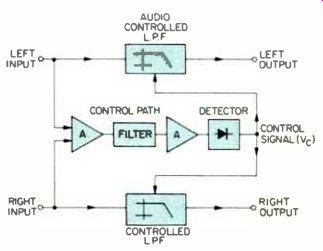
Fig. 1--A breakdown of the essential operators in the DNR system, all of which
are contained within a single IC.
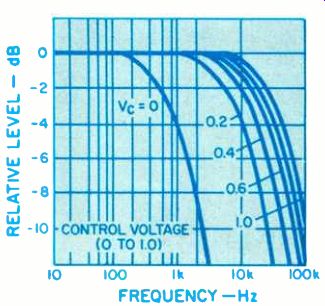
Fig. 2--Increasing control voltages, derived from a network that responds
more to higher frequencies in the program, open the DNR passband until it extends
well beyond the audio range.
-----------
THE CIRCUIT
The LM1894 is a 14-pin DIP intended to operate with supply voltages from 4.5 to about 18. Current drawn is 12 milliamperes for a typical Supply voltage of 8. Input impedance is approximately 20 kilohms; input overload occurs at 1 volt rms.
Figure 3 is a block diagram of the IC itself; Fig. 4 is a suggested external for the IC. The circuit primary external operators for the audio channels are C3 and C12, which determine the bandwidths passed by the filters. Since bandwidth is inversely proportional to capacitance, the frequency range of the noise-reduction effect can be adjusted by changing C5 the and capacitiveC6 values the Capacitors band determine of program frequencies to which the control circuit responds--in this case roughly 6 kHz and above. The voltage divider formed by R1 and R2 sets the threshold of the control path, which is normally adjusted so that steady state noise from the program source just begins to open the filters.
Resistors R1 and R2 are altered together so that their sum always equals 1 kilohm. Wiring a suitable potentiometer in their place creates a threshold-varying control.
Coil L8 and the components surrounding it comprise a 19-kHz notch filter which prevents the stereo FM pilot signal from affecting the operation the control circuit. If the DNR module will not be used for FM, or if the tuner has an adequate multiplex filter of its own, these components can be replaced by a simple 0.047-µF capacitor bridging pins 8 and 9.
National Semiconductor foresees and has demonstrated the use of LM1894s in cascaded arrays of two or three, in which case the slopes of Fig. 2 become 12 or 18 dB per octave, and the noise-reduction effect becomes 20 dB or greater.
The LM1894 is available in quantity to manufacturers of licensed products for about $2 apiece. The price is expected to decline as production increases. It is not presently available in small quantities or to unlicensed manufacturers.
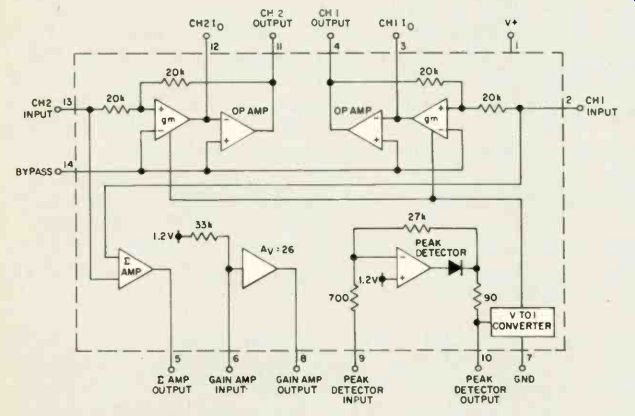
Fig. 3--Block diagram of the LM1894.

Fig. 4--Schematic of suggested external circuit for LM1894. IC pin designations
correspond to those of Fig. 3.
-----------------------
== === === ==
(adapted from Audio magazine, Nov 1981)
Also see:
Dolby B-Type Noise Reduction System--part 1 (Sept. 1973)
Dolby B-Type Noise Reduction System--Part 2 (Oct. 1973)
Introducing Dolby S-Type Noise Reduction (Jun. 1990)
EQ & NR: Striking A Balance (Aug. 1988)
Deck to Deck Matching and NR: Straightening the Mirror (Aug. 1986)
A Dynamic Noise Filter for Mastering (June 1972)
Dolby C-Type Noise Reduction (May 1981)
= = = =